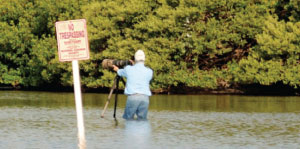By Ann Paul and Mark Rachal,
Audubon Florida

The Tampa Bay region supports some of the largest and most important waterbird nesting colonies in the state. We have bustling tree islands full of brown pelicans and impossibly pink roseate spoonbills, plus herons, egrets, white ibis, and wood storks raising their young. In other places, birds make small hollows in the sand and nest directly on the beaches.
Unfortunately, nesting birds are very vulnerable to disturbance when people approach them too closely. As parent birds flee from approaching observers, eggs and chicks are left exposed to the sun, vulnerable to predators like crows, and prone to falling from their nests to their deaths.
For more than 75 years, Audubon wardens in Tampa Bay have been the keepers of these special places. At first, we protected them from the plume trade and harvest for food that almost drove these birds to extinction. But today, these nesting birds face a new and unexpected threat: catastrophic disturbance by nature photographers. And worse, a few unscrupulous tour leaders in Tampa Bay are giving nature photography a bad name, and threatening the future of our area’s vibrant waterbird colonies.
The Problem
You might think “how much damage can one photographer do?” The impacts are cumulative and substantial. Some nature photographers lead customers on photo “safaris,” including vulnerable nesting colonies among their destinations. With clients in tow, some paying $450 per day to be escorted to prime sites, these tour operators are becoming serial disturbers.
Pressured to deliver the best shots for their customers, many tour leaders approach the islands too closely. Then they allow clients to wade in even closer with their equipment, past signs and in spite of being told by Audubon wardens that their actions endanger birds. These unscrupulous leaders are harming the wildlife that they depend upon for their living, including some of Florida’s rarest species — reddish egrets, roseate spoonbills and American oystercatchers.
The Damage
American oystercatchers, among Florida’s rarest bird species, are a perfect example of the problem. They walk away from their nests if people approach by boat or on foot, trusting the excellent camouflage of their eggs, laid in shallow hollows on the sand just above the high tide line, for protection. However, if the day is hot, the sand can cook the delicate embryos inside the eggs in minutes. Even if the weather is nice, sharp-eyed aerial predators like fish crows will steal the eggs in the time it takes the human intruders to leave so the adult can return to protect the nest. Sad to say, we have documented photographers trespassing on posted sanctuary shorelines, and watched as crows stole eggs from oystercatcher nests while the helpless parents hovered nearby.
Less visible but just as harmful for birds are intrusions that occur when rare wading birds are courting. Surveys at the Alafia Bank Bird Sanctuary are finding fewer nesting reddish egrets and roseate spoonbills each year. We fear this troubling decline is due in part to relentless disturbance by nature photographers coming to the sanctuary at dawn and dusk which is when courtship occurs.
When birds are trying to attract mates, their plumage displays are at their most spectacular. Exploiting this opportunity, photographers wade to sandbars where birds gather to select mates, disrupting the sensitive process. Then, a few weeks later when the photogenic young egrets and spoonbills fledge but are still being fed by their parents, photographers are there again, creating “no-bird” zones where the birds could forage if intruders were not present.
Photographers, having been taught to approach too closely by their photography “safari” leaders, return on their own or go to other colony sites. Fishermen, kayakers, and other boaters, having observed the example of photographers in so close, use those distances as “guidelines,” creating a continuous cycle of disturbance.
How You Can Help?
Give the birds room and set a good example.
Of course, most nature photographers are not unethical. The North American Nature Photography Association has endorsed Ethical Photography Practices; and effective guidelines are being promoted by the Florida Shorebird Alliance and even our local Audubon chapters.
These days, with the innovations in digital cameras and lenses, many people can enjoy nature photography and share their experiences. But because this activity has become so popular, it’s critical that the places that we value and the wildlife we love are protected for the future. Intrusion and disturbance of birds at nest, roost, and forage sites when they are most vulnerable is inexcusable.
We ask everyone — boaters, nature photographers, bird-watchers, hikers, kayakers, beach-goers — while you are near bird nesting colonies, the beaches and shores where birds congregate, and the habitats where they forage, to be aware of potential impacts, to avoid disturbance, and to set a good example for others.
As our area’s human population increases, protection of our natural resources — both the wildlife and the habitats that support it — becomes more challenging. It will take all of us working together to ensure that the special and spectacular bird populations, fish, dolphins, manatees, turtles, and all the other wildlife denizens of our community survive in the future. It is both our responsibility and our sacred trust.
Learn more:
Visit www.nanpa.org/docs/NANPA-Ethical-Practices.pdf for the National Association of Nature Photographers’ ethical practices guidelines
www.flshorebirdalliance.org/Wordpress-FSA/wp-content/uploads/2013/01/SNPLWG-Photographer-Guidelines020122.pdf for the Florida Shorebird Alliance photographer guides
www.baysoundings.com/lovehurts for comments from local nature photographers on how to ethically capture images while respecting wildlife — and photos of some who blatantly ignore sanctuary boundaries.
[su_divider] Originally published Spring 2013